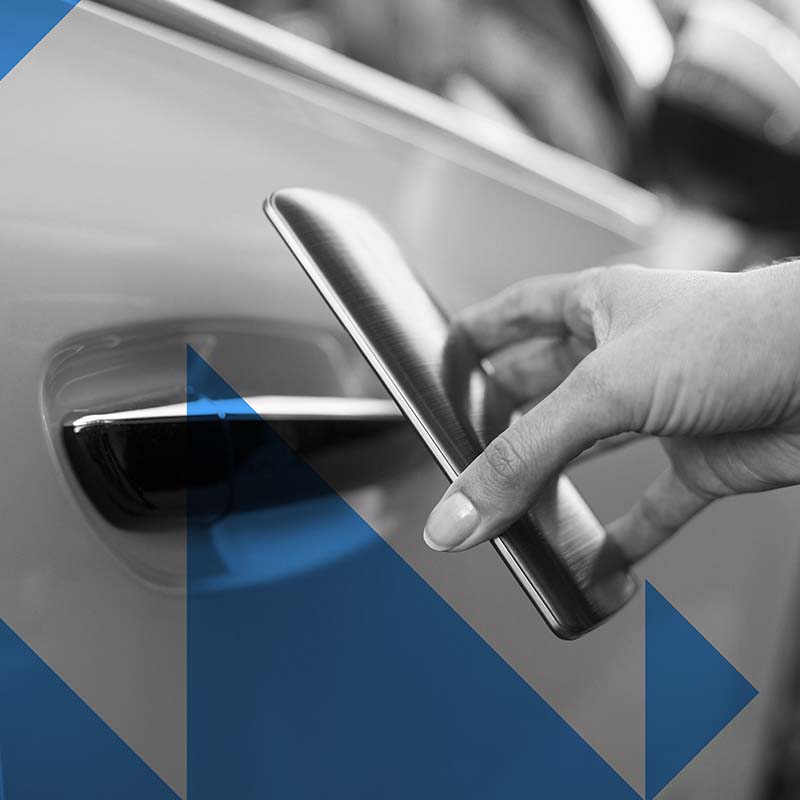Can My Smartphone Unlock My Car?
I’m usually good about keeping track of my valuables (wallet, phone, gum, etc.). But, last week, for the first time ever, I locked my keys in my car. It was a simple mistake. While dropping off a friend at the ferry terminal, I was so distracted making sure they hadn’t left any valuables behind that I forgot to keep track of my own.
Later, as I stood alone in an overcast parking lot, my jacket pulled tight while the wind bit my nose and ears, I fumed at my absent-minded folly. At least I hadn’t locked my phone in the car. It was going to take almost two hours for help to arrive, but help was on the way. That said, it would have been great if my phone could have just solved the problem for me. From paying bills to keeping track of my calendar to streaming entertainment, my phone does just about everything. How can I use my phone to unlock my car?
Bluetooth Access Control for Your Car

While passive keyless entry (PKE) is nothing new, there’s a big push to include that capability as part of the smartphone experience. According to Chuck Sabin, senior director of market development and business strategy for the Bluetooth Special Interest Group (SIG), the initial market for using Bluetooth® technology as a means of access control (using the smartphone as a mechanism for locking/unlocking) is in automotive.
A new expansion of Bluetooth technology in your smartphone will be the capability to use it as key fob. So, when you approach your car, it will recognize you as the owner and unlock the doors. “Anytime you need security of authorization to enter an area is essentially what we mean by access control within the context of the phone,” said Sabin. “And while there are plenty of instances where you could use Bluetooth technology in a key fob or card, the smartphone is now being tasked to replace those devices.”
This technology supports a wide range of flexibility and customization in how it’s applied. For example, you could program your smartphone to only open/unlock certain doors (car doors/trunk) that you use regularly without unlocking others. This can be advantageous if you routinely find yourself walking through a dark parking lot with an arm full of groceries.
“Utility vehicles, like those on construction projects, are a great example of where this technology will be used,” said Sabin. “Think about someone needing to repeatedly go back and forth to collect tools and supplies. As they near the vehicle they can gain access, and as they walk away, it locks. You don’t have to think about.”
ABI Research forecasts that by 2023, access control in automotive devices and accessories is expected to see a 13 percent CAGR (compound annual growth rate). But cars aren’t the only application for this innovation. The locks in your home or office could also benefit from Bluetooth enabled access control, granting you entry as you near the door.
Bluetooth PKE for Smart Industry
“The roadmap of Bluetooth® is moving towards more fine-tuned solutions.”
Chuck Sabin, Bluetooth SIG
Beyond cars and homes, there is a range of commercial applications for this innovation. Security in industrial facilities like warehouses, factory floors, and chemical plants needs to prohibit employees without proper training from accessing hazardous areas. “Industrial complexes are using the phone as a way of identifying individuals to give them access to restricted areas,” said Youngji Kim, Bluetooth SIG market analyst.
With the added value of location-based services like asset/personnel tracking and geofencing, alerts can be sent to your smartphone should you wander close to or enter a hazardous area, keeping you and those around you safe. And, should an emergency happen, first responders can locate and get to you quicker if they know your exact position and status in a facility.
What About Badges and Key Cards?
As your smartphone is always with/near you, it’s an ideal central arbitrator of access control. Since badges and key cards are single purpose, they have a greater chance of being lost or misplaced. The smartphone is a vital component to daily living, making it a clear choice, streamlining access control down to a single device that carries all your credentials.
Plus, the smartphone is a dynamic device. It would allow you to transfer temporary access for your home or car to others. “Imagine if you have house guests or are lending your car to a friend for the day,” said Sabin. “The phone provides a simple, efficient means of giving access without having to program locks or doors. We always have our phones, even if we forget our keys.”
In my situation, it was second nature to have my phone on me all the time. But misplacing my keys left me out in the cold. I’m looking forward to seeing more Bluetooth® enabled innovations like access control included in my phone.